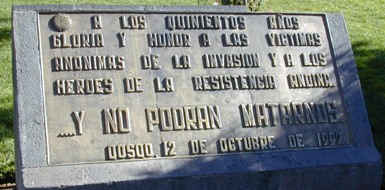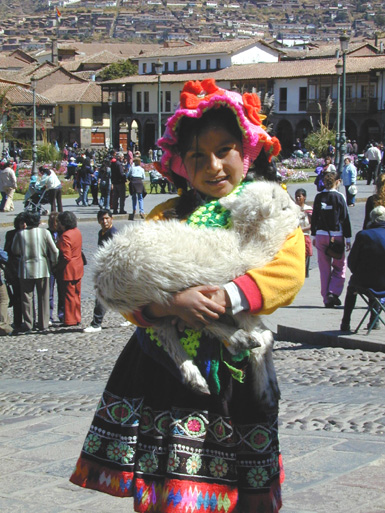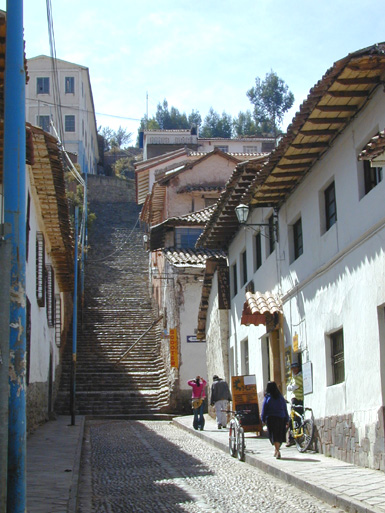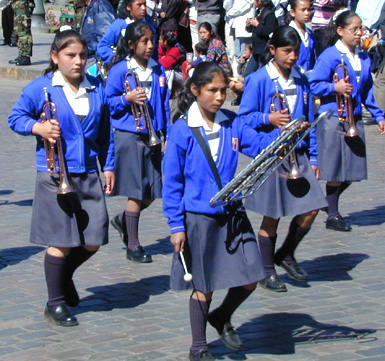
"At the 500th Anniversary -- Praise and honor to all the anonymous victims and to the heroes of the Andean resistance -- they could not kill us all! Cusco, October 12, 1992"
In Inca times, this city was "the navel of the universe," the capital of the empire from 1458 to 1532. The Incas seem to have been similar to the Romans in Europe: brilliant organizers of subject peoples who had already developed cultural riches, binding the whole together with roads, public works, an army, and an imperial cult.
Spanish conquerors briefly ruled from here in the mid-16th century before moving the capital of Spanish America to Lima. Today Cusco claims to be at the center of the Fourth World, the indigenous world, as the monument shown above asserts. Certainly spirited engagement with politics seems common: in a week's time we saw protest marches by school administrators and campesinos.
Cusco is a wonderful experience for the tourist, thoroughly geared to separating the visitor from her dollars -- and delivering just the right combination of visible history and an exotic present to make the experience thoroughly delightful.

This young woman is working to support her family, posing for pictures in the hope of getting tips averaging 1 Nuevo Sol (35 cents) per shot. On a good weekday, I doubt these children make more than 20 S/, about $7, but this is a major contribution. The municipal police, protecting the interests of town merchants, hassle rural people like this child who try to get their bit of the tourist trade.
In the old city, a maze of narrow cobblestone streets around a Plaza des Armas, most of the visible monuments, including ornate gilded churches, are of Spanish vintage. But their foundations are the Inca stonework. The invading Spaniards, fresh from driving Muslims and Jews from Spain, destroyed all Inca buildings with full crusading zeal. But they then used the foundations (and indigenous craftspeople) to build their colonial city. However, the town is subject to earthquakes. In 1650 and 1950 major shakes damaged many Spanish buildings (the more prosperous ones since repaired.) The Inca foundations survived intact.

Cusquenos seem to be enterprising and busy. Many speak Quechua (the local indigenous language), as well as Spanish and often some English. One of our acquaintances assured us "we are all mestizos [mixed heritage, indigenous and European] now," but it is hard for a tourist to gauge how widespread that characterization is.

Educators marching against reorganization
Just when one begins to wonder whether the whole city is just an elaborate stage set for tourism, along comes the weekly Sunday morning parade in which enthusiastic school bands, sports clubs, and professional societies march to the applause of their neighbors and families. It is a little hard to tell what this exercise is about, but it is clear that whatever it is, it commands the delighted participation of the people of Cusco.

Located at 11,300 feet above sea level, the city is a great place to acclimatize before undertaking higher Andean treks or the Inca trail pilgrimage to Machu Picchu. Hotels are eager to help you get used to the altitude -- the local remedy for altitude queasiness is coca tea, freely supplied at every turn. It does not give a buzz. If that doesn't work there are always "pisco sours," a sweet brandy cocktail that is the national drink of Peru.
No comments:
Post a Comment